
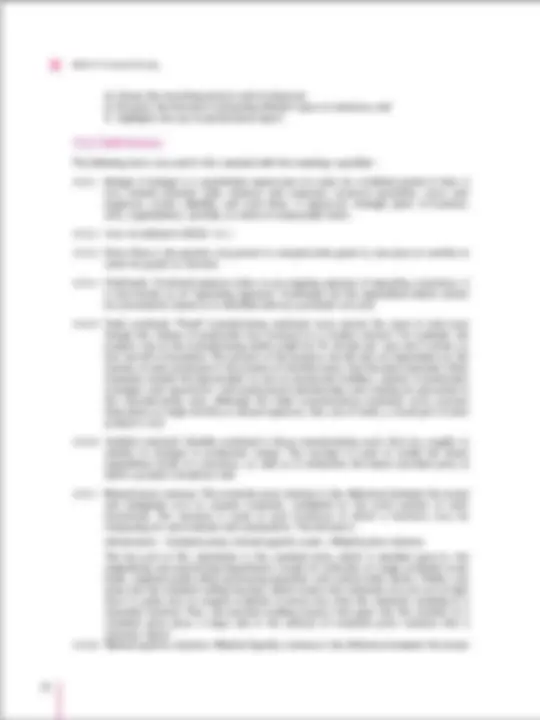
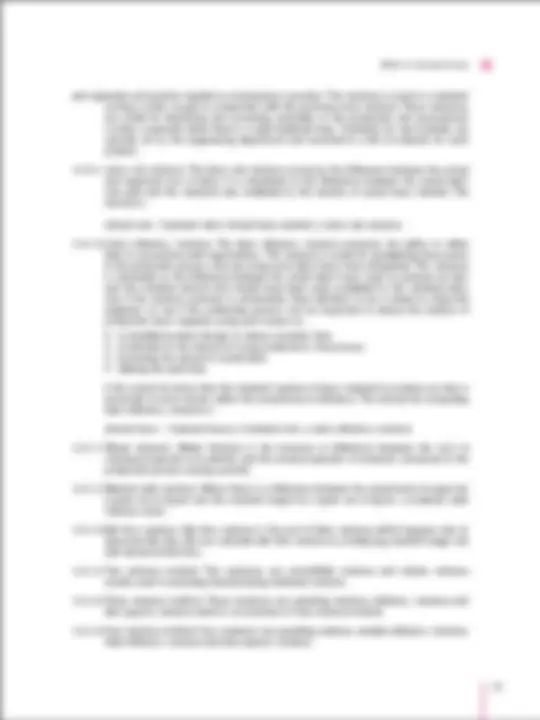
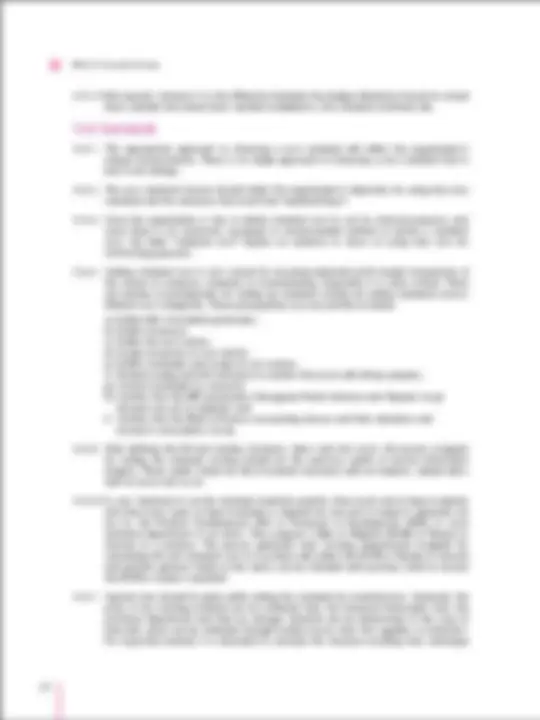
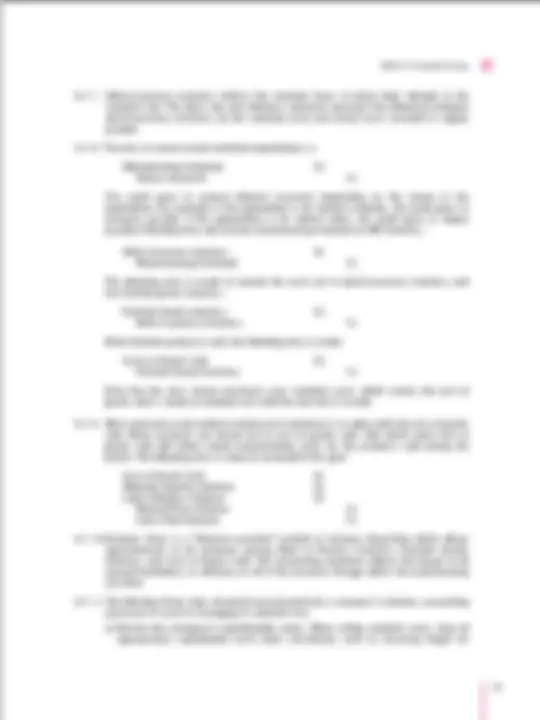
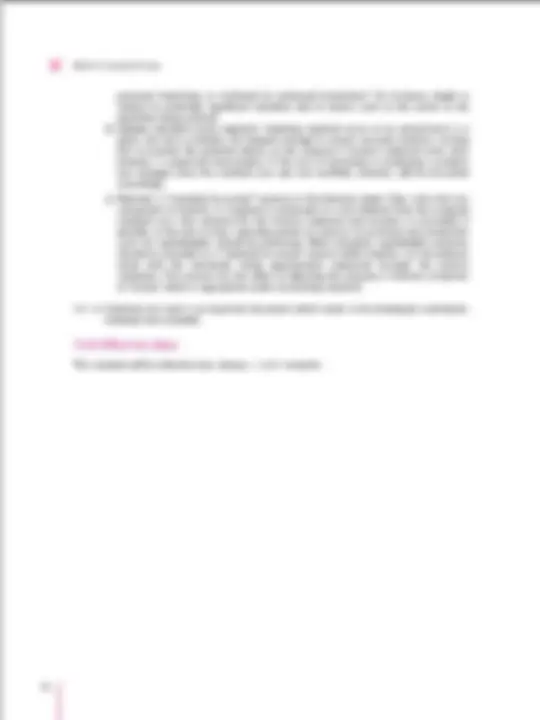
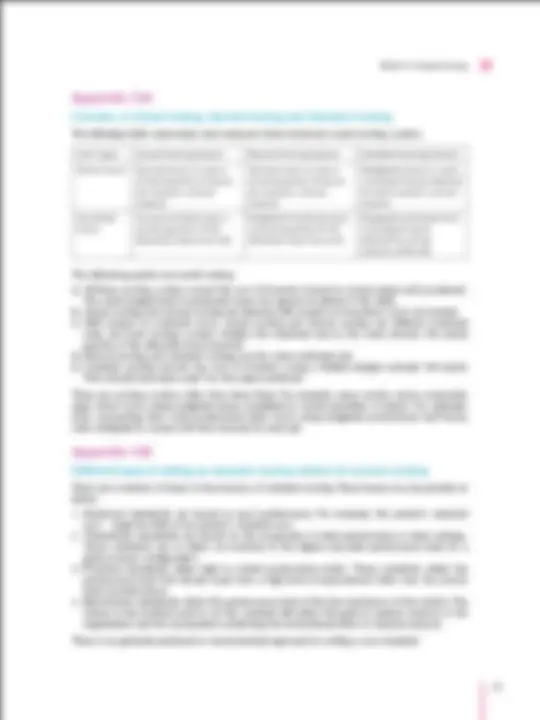
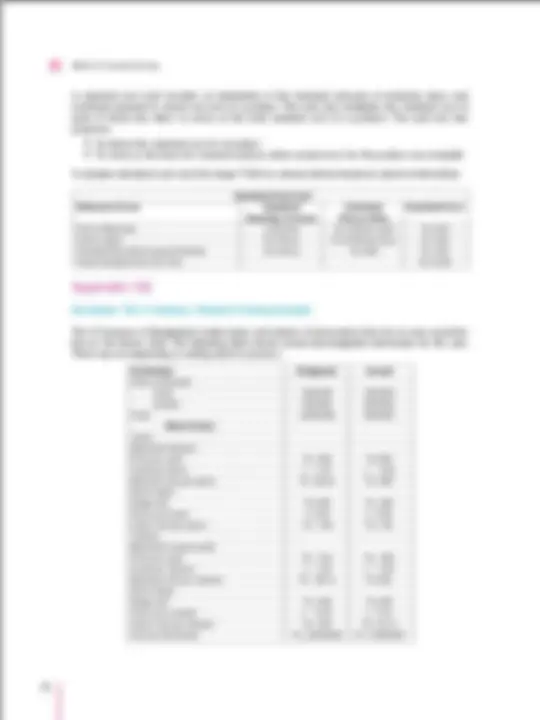



Study with the several resources on Docsity

Earn points by helping other students or get them with a premium plan


Prepare for your exams
Study with the several resources on Docsity

Earn points to download
Earn points by helping other students or get them with a premium plan
Community
Ask the community for help and clear up your study doubts
Discover the best universities in your country according to Docsity users
Free resources
Download our free guides on studying techniques, anxiety management strategies, and thesis advice from Docsity tutors
Guidelines for implementing standard costing in Bangladeshi manufacturing companies. It covers the principles of standard setting, categories of variances, recording and disposal of variances, and the role of variance analysis in cost control. Key features of standard costing include the use of standard cost cards, different types of variance methods, and the importance of updating standard costs regularly.
What you will learn
Typology: Study notes
1 / 14

This page cannot be seen from the preview
Don't miss anything!









Standard costing is an important area of cost accounting. Standard costs are usually associated with a manufacturing company's costs of direct material, direct labor, and manufacturing overhead. Rather than assigning the actual costs of direct material, direct labor, and manufacturing overhead to a product, many manufacturers assign the expected or standard cost. This means that a manufacturer's inventories and cost of goods sold will begin with amounts reflecting the standard costs, not the actual costs, of a product. Manufacturers, of course, still have to pay the actual costs. As a result there are almost always differences between the actual costs and the standard costs, and those differences are known as variances. Standard costing and the related variances is a valuable management tool for control purpose. If a variance arises, management becomes aware that manufacturing costs have differed from the standard (planned, expected) costs that warrant careful attention. This standard covers standard costing and resulting variance analysis mechanisms as applied in firms.
The objective of this standard is to provide guidelines to firms using or planning to use standard costing. More particularly, this standard targets to present guidelines to ease implementation of standard costing on following areas:
a) Establishing budgets; b) Controlling costs and motivating and measuring efficiencies; c) Promoting possible cost reduction; d) Simplifying costing procedures and expediting cost reports; and e) Assigning costs to materials, work in process, and finished goods inventories.
13.3.1 The purpose of this standard is to define the managerial role of variance reporting and the role played by standard costs in identifying variances.
13.3.2 More particularly, the standard prescribes -
a) Standard setting principles b) Category of variances c) Keeping record of variances and its disposal d) Application of variance analysis e) Managerial issues in standard setting and analysis of variances
13.3.3 This standard may be followed by companies and other business or non-business organizations where cost and management accounting is in practice either as a statutory obligation or to support management decision making process.
The key features of this standard are pointed below -
a) Presents different type of standards; b) Introduces standard cost card; c) Puts light on the application of standard costing and resultant variance analysis;
and expected unit quantity needed to manufacture a product. The variance is used in a standard costing system, usually in conjunction with the purchase price variance. These variances are useful for identifying and correcting anomalies in the production and procurement systems, especially when there is a rapid feedback loop. Standards for raw materials are typically set by the engineering department and recorded in a bill of materials for each product.
13.5.9 Labor rate variance: The labor rate variance measures the difference between the actual and expected cost of labor. It is calculated as the difference between the actual labor rate paid and the standard rate, multiplied by the number of actual hours worked. The formula is:
(Actual rate - Standard rate) x Actual hours worked = Labor rate variance
13.5.10 Labor efficiency variance: The labor efficiency variance measures the ability to utilize labor in accordance with expectations. The variance is useful for spotlighting those areas in the production process that are using more labor hours than anticipated. This variance is calculated as the difference between the actual labor hours used to produce an item and the standard amount that should have been used, multiplied by the standard labor rate. If the variance outcome is unfavorable, there will likely to be a review by industrial engineers to see if the underlying process can be improved to reduce the number of production hours required, using such means as: l (^) A simplified product design to reduce assembly time l (^) A reduction in the amount of scrap produced by the process l (^) Increasing the amount of automation l (^) Altering the work flow
If this cannot be done, then the standard number of hours required to produce an item is increased to more closely reflect the actual level of efficiency. The formula for computing labor efficiency variance is:
(Actual hours - Standard hours) x Standard rate = Labor efficiency variance
13.5.11 Mixed variance: Mixed Variance is the measure of difference between the cost of standard proportion of materials and the actual proportion of materials consumed in the production process during a period.
13.5.12 Material yield variance: Where there is a difference between the actual level of output for a given set of inputs and the standard output for a given set of inputs, a materials yield variance arises.
13.5.13 Idle time variance: Idle time variance is the part of labor variance which happens due to abnormal idle time. We can calculate idle time variance by multiplying standard wage rate with abnormal idle time.
13.5.14 Two variance method: Two variances are controllable variance and volume variance usually used in analyzing manufacturing overhead variance.
13.5.15 Three variance method: Three variances are spending variance, efficiency variance and idle capacity variance which is an extension of two variance method.
13.5.16 Four variance method: Four variances are spending variance, variable efficiency variance, fixed efficiency variance and idle capacity variance.
13.5.17 Idle capacity variance: It is the difference between the budget allowance based on actual hours worked and actual hours worked multiplied by the standard overhead rate.
13.6.1 The appropriate approach to choosing a cost standard will reflect the organization's unique circumstances. There is no single approach of choosing a cost standard that is best in all settings.
13.6.2 The cost standard chosen should reflect the organization's objectives for using that cost standard and the variances that result from implementing it.
13.6.3 Since the organization is free to define standard cost to suit its internal purposes, and since there is no commonly accepted or recommended method to derive a standard cost, the label "standard cost" implies no authority in terms of using that cost for contracting purposes.
13.6.4 Setting standard cost is very crucial for ensuring expected profit margin irrespective of the nature of company; however, in manufacturing companies it is more critical. There are number of prerequisites for setting up standard costing via setting standards across different cost categories. These prerequisites may be pointed as below: a) Define bills of material parameters; b) Define resources; c) Define the cost centre; d) Assign resources to cost centre; e) Define overheads and assign to cost centre; f) Review routing and bill structures to confirm that costs will roll-up properly; g) Control overheads by resource; h) Confirm that the WIP parameters, Recognize Period Variance and Require Scrap Account are set as required; and i) Confirm that the Work in Process accounting classes and their valuations and accounts are properly set up.
13.6.5 After defining the bill and routing structures, items and unit costs, the person assigned for setting the standard costing should run the summary audits to ensure information integrity. These audits check for bill of material structures with no headers, valued items with no costs and so on.
13.6.6 It is very technical to set the standard materials quantity. How much unit of input materials and how many types of input materials is required for one unit of output is generally set out by the Product Development (PD) or Research & Development (R&D) or such technical department of an entity. They prepare a Bills of Material (BOM) or Recipe or formula of a product. The person (generally from Costing Department) assigned for calculating the unit standard cost of a product will collect the BOM or Recipe or formula and perform general review of the same, can be checked with previous trend to ensure the BOM or recipe is updated.
13.6.7 Special care should be given while setting the standard for material price. Generally, the price of any existing material can be collected from the historical information from the purchase department and then an average standard can be determined. In the case of new item, price can be collected through market survey, from the suppliers or indenters. For imported material, it is desirable to consider the variance resulting from exchange
requirement or the problem. Thus, it supplements the application of 'Management by Exception' principle.
13.7.1 Variances should be journalized in such a way that will supplement variance analysis for evaluation and control purpose. Standard costing systems assist in this process and often involve recording transactions using standard cost information. When accountants use a standard costing system to record transactions, companies are able to quickly identify variances. In addition, inventory and related cost of goods sold are valued using standard cost information, which simplifies the bookkeeping process.
13.7.2 Two journal entries are needed to record transactions relating to direct materials that include these variances. Typically, many more journal entries would be made throughout the year for direct materials. For the purposes of this example, we will make one journal entry for each variance to summarize the activity for the year. The entry to record the purchase of direct materials and related price variance is -
Raw Materials Inventory Dr. Materials Price Variance (UNF) Dr. Trade Payables Cr.
13.7.3 Notice that the raw materials inventory account contains the actual quantity of direct materials purchased at the standard price. Payable reflects the actual cost, and the materials price variance account shows the unfavorable variance. Unfavorable variances are recorded as debits and favorable variances are recorded as credits. Variance accounts are temporary accounts that are closed out at the end of the financial reporting period.
13.7.4 The entry to record the use of direct materials in production and related quantity variance is
Work in process Inventory Dr. Materials Quantity Variance Cr. Raw Materials Inventory Cr.
13.7.5 Work-in-process inventory reflects the standard quantity of direct materials allowed at the standard price. The reduction in raw materials inventory reflects the actual quantity used at the standard price and the materials quantity variance account shows the favorable variance.
13.7.6 Labor is not inventoried for later use like materials; thus, only one journal entry is needed to record transactions relating to direct labor. Again, many more journal entries would typically be made throughout the year for direct labor. For the purposes of this example, we will make one journal entry to summarize the activity for the year. The entry to record the cost of direct labor and related variances is -
Work in process Inventory Dr. Labor Rate Variance (UNF) Dr. Labor Efficiency Variance (F) Cr. Wages Payable Cr.
13.7.7 Work-in-process inventory reflects the standard hours of direct labor allowed at the standard rate. The labor rate and efficiency variances represent the difference between work-in-process inventory (at the standard cost) and actual costs recorded in wages payable.
13.7.8 The entry to record actual overhead expenditures is -
Manufacturing Overhead Dr. Various Accounts Cr.
The credit goes to several different accounts depending on the nature of the expenditure. For example, if the expenditure is for indirect materials, the credit goes to accounts payable. If the expenditure is for indirect labor, the credit goes to wages payable. Following entry will transfer manufacturing overhead to WIP Inventory -
Work in process Inventory Dr. Manufacturing Overhead Cr.
The following entry is made to transfer the costs out of work-in-process inventory and into finished goods inventory -
Finished Goods Inventory Dr. Work in process Inventory Cr.
When finished product is sold, the following entry is made:
Costs of Goods Sold Dr. Finished Goods Inventory Cr.
Note that the entry shown previously uses standard costs, which means the cost of goods sold is stated at standard cost until the next entry is made.
13.7.9 Most commonly used method of disposal of variances is to adjust with the cost of goods sold. When accounts are closed out to cost of goods sold, after which point cost of goods sold will reflect actual manufacturing costs for the products sold during the period. The following entry is made to accomplish this goal:
Cost of Goods Sold Dr. Materials Quantity Variance Dr. Labor Efficiency Variance Dr. Material Price Variance Cr. Labor Rate Variance Cr.
13.7.10 However, there is a "Variance proration" method of variance disposition which allows apportionment of all variances among Work in Process Inventory, Finished Goods Inventory, and Cost of Goods Sold. This accounting treatment reflects the impact of all unusual inefficiency or efficiency in all of the accounts through which the manufacturing cost flow.
13.7.11 The following three steps should be incorporated into a company's inventory accounting processes to assist in managing its standard cost: a) Review the company's capitalizable costs: When setting standard costs, have all appropriately capitalizable costs been considered, such as incoming freight for
The following table summarizes and compares three commonly-used costing systems.
The following points are worth noting:
a) All three costing systems record the cost of inventory based on actual output units produced. The static budget level of production does not appear anywhere in this table. b) Actual costing and normal costing are identical with respect to how direct costs are treated. c) With respect to overhead costs, actual costing and normal costing use different overhead rates, but both costing systems multiply the overhead rate by the same amount: the actual quantity of the allocation base incurred. d) Normal costing and standard costing use the same overhead rate. e) Standard costing records the cost of inventory using a flexible budget concept: the inputs "that should have been used" for the output achieved.
There are costing systems other than these three. For example, some service sector companies apply direct costs using budgeted prices multiplied by actual quantities of inputs. For example, many accounting firms track professional labor costs using budgeted professional staff hourly rates multiplied by actual staff time incurred on each job.
There are a number of bases in the process of standard costing. These bases may be pointed as below:
There is no generally preferred or recommended approach to setting a cost standard.
Cost Types Actual Costing System Normal Costing System Standard Costing System Direct Costs: (Actual prices or rates x actual quantity of inputs per output) x actual outputs
(Actual prices or rates x actual quantity of inputs per output) x actual outputs
(Budgeted prices or rates x standard inputs allowed for each output) x actual outputs Overhead Costs:
Actual overhead rates x actual quantity of the allocation base incurred
Budgeted overhead rates x actual quantity of the allocation base incurred
Budgeted overhead rates x (standard inputs allowed for actual outputs achieved)
How should the ideal standards for better controlling be determined? Consider the following issues:
"A cost center is a department or part of a department or an item of equipment or machinery or a person or a group of persons in respect of which costs are accumulated, and one where control can be exercised." Cost centers are necessary for determining the costs. If the whole factory is engaged in manufacturing a product, the factory will be a cost center. In fact, a cost center describes the product while cost is accumulated. Cost centers enable the determination of costs and fixation of responsibility. A cost center relating to a person is called personnel cost center, and a cost center relating to products and equipments is called impersonal cost center.
A current standard is a standard which is established for use over a short period of time and is related to current condition. It reflects the performance that should be attained during the current period. The period for current standard is normally one year. It is presumed that conditions of production will remain unchanged. In case there is any change in price or manufacturing condition, the standards are also revised. Current standard may be ideal standard and expected standard.
This is the standard which represents a high level of efficiency. Ideal standard is fixed on the assumption that favorable conditions will prevail and management will be at its best. The price paid for materials will be lowest and wastes etc. will be minimum possible. The labor time for making the production will be minimum and rates of wages will also be low. The overheads expenses are also set with maximum efficiency in mind. All the conditions, both internal and external, should be favorable and only then ideal standard will be achieved. Ideal standard is fixed on the assumption of those conditions which may rarely exist. This standard is not practicable and may not be achieved. Though this standard may not be achieved, even then an effort is made. The deviation between targets and actual performance is ignorable. In practice, ideal standard has an adverse effect on the employees. They do not try to reach the standard because the standards are not considered realistic.
A basic standard may be defined as a standard which is established for use for an indefinite period which may be a long period. Basic standard is established for a long period and is not adjusted to the preset conditions. The same standard remains in force for a long period. These standards are revised only on the changes in specification of material and production technology. It is indeed just like a number against which subsequent process changes can be measured. Basic standard enables the measurement of changes in costs. For example, if the basic cost for material is Tk. 20 per unit and the current price is Tk. 25 per unit, it will show an increase of 25% in the cost of materials. The changes in manufacturing costs can be measured by taking basic standard, as a base standard cannot serve as a tool for cost control purpose because the standard is not revised for a long time. The deviation between standard cost and actual cost cannot be used as a yardstick for measuring efficiency.
A standard cost card contains an itemization of the standard amounts of materials, labor, and overhead required to create one unit of a product. The card also multiplies the standard cost of each of these line items to arrive at the total standard cost of a product. The card has two purposes:
l (^) To derive the standard cost of a product l (^) To serve as the basis for variance analysis when actual costs for the product are compiled
A sample standard cost card for large T-Shirt is drawn below based on above information:
Standard Cost Card Element of Cost Standard Standard Standard Cost Quantity or Hours Price or Rate Direct Materials 2.00 yard Tk. 3.00 per yard Tk. 6. Direct Labor 0.5 Hours Tk. 10.00 per hour Tk. 5. Variable Manufacturing Overhead 0.5 Hours Tk. 2.00 Tk. 1. Total Standard Cost Per Unit Tk. 12.
Illustration: The X Company, Standard Costing Example
The X Company in Bangladesh makes jeans and jackets. Each product line has its own assembly line on the factory floor. The following table shows actual and budgeted information for the year. There was no beginning or ending work-in-process.
Particulars Budgeted Actual Units produced: Jeans 500,000 500, Jackets 500,000 400, Total 1,000,000 900, Direct Costs: Jeans: Materials (denim) Price per yard Tk. 384 Tk. 400 Yards per jeans x 1.10 x 1. Material cost per jeans Tk. 422.4 Tk. 400 Direct labor Wage rate Tk. 300 Tk. 290 Hours per jeans x 0.50 x 0. Labor cost per jeans Tk. 150 Tk. 116 Jackets: Materials (cotton twill) Price per yard Tk. 352 Tk. 360 Yards per Jackets x 1.10 x 1. Material cost per Jackets Tk. 387.2 Tk. 432 Direct labor Wage rate Tk. 300 Tk. 290 Hours per Jackets x 0.70 x 0. Labor cost per Jackets Tk. 210 Tk. 217. Factory Overhead Tk. 3,600,000 Tk. 3,300,
Assume that, the budgeted overhead rate of Tk. 250 per direct labor hour and that same overhead rate is used by the standard costing system. Based on this information, the standard costing system would debit the finished goods inventory account as follows:
Particulars Jeans Jackets Standard cost per unit: Materials Tk. 422.4 Tk. 387. Labor Tk. 150.0 Tk. 210. Overhead Tk. 250 x 0.50 = Tk. 125.0 Tk. 250 x 0.70 = Tk. 175. Tk. 697.4 Tk. 772. Actual units produced x 500,000 x 400, Total Tk. 34,87,00,000 Tk. 30,88,80,
As per record The X Company sold 400,000 jeans and 350,000 Jackets. The entries to record the movement of inventory from the finished goods inventory account into the cost-of-goods-sold account would multiply these sales volumes by Tk. 697.4 per jeans and Tk. 772.2 per jackets.
A performance report provides a clear-cut idea regarding the status of achieving target by the management and possible areas for improvement. A specimen format may be as follows which may be customized to suit the specific needs of the particular firm.
ABC Company Performance Report For the Month ended on June 30, YYYY Element of Cost Actual Costs Standard Cost at Cost Variance Actual Volume - (F)/UFV Direct Materials Tk. 40,150 Tk. 37,500 Tk. 2, Direct Labor Tk. 38,500 Tk. 36,000 Tk. 2, Variable Manufacturing Overhead Tk. 22,400 Tk. 24,000 (Tk. 1,600) Total Standard Cost Per Unit Tk. 101,050 Tk. 97,500 Tk. 3,